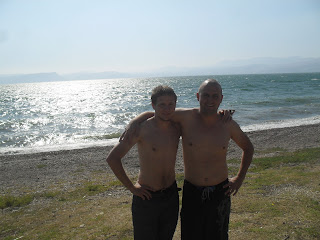The history of the Jewish people is
not a particularly positive one – wars, genocide, and discrimination are major
parts of their experiences. Some of my
travels here have particularly impressed these experiences on me. We visited
the Anne Frank Huis in Amsterdam and saw firsthand a memory of the Holocaust.
Today we were able to visit the Independence Hall in Tel Aviv and hear about
the history of Israel. Even in this brief history of Israel, which begins with
the first Jewish settlement of Israel in the 1880s, Jews could not escape
animosity. Jews in Israel were exiled by the Turks, then taken over by British
Mandate, and then the atrocity of the Holocaust in the 1940s –which leaves very
little time when the Jewish people could feel accepted anywhere – until the
birth of the Jewish State, Israel. In more recent history, Israel is constantly
under attack by surrounding countries. Bomb shelters and rockets are not uncommon for
the people who live here. With this past and present of injustice and
intolerance, Israel could easily turn to hate as well. It would almost be
understandable if the Jewish people sought to destroy all who have perpetuated
unfairness and violence against them. If they chose revenge and vindictiveness
against their oppressors (which are many) I cannot say I would have blamed
them. However, after spending just a short time in Tel Aviv, it seems that
these people have made a very different choice.
Upon visiting the ancient city of
Yafo, the first sight that struck me was a theater entitled “The Jew-Arab
Theater of Jaffa” whose mission is to unite both Arabic and Hebrew speakers in
the creative and performing arts, and to celebrate the contributions of both
peoples. During my visit to the port in Yafo,
I saw a group of Muslim families boarding a boat to tour the harbor. Walking
down the streets of Tel Aviv, I can easily see the diversity among the people.
Not only with Jews of all kinds, both reformed and orthodox, but Arab women
wearing hijabs, and even blonde, pale people like me! It is fascinating to see
how the Jewish people have endured such injustice and yet broken the cycle and
are striving to create a tolerant and accepting homeland. Even in the face of
current oppression, Israel seeks to push forward and create a brighter future
for all who live in Israel.
There is nothing unusual about the
purpose of Israel. Simply, it is the desire to have a homeland and basic human
rights – something that I, and many others, are privileged to have both
of. What is incredibly unusual, however,
is that these people wish to do this through patience, humanity, and tolerance.
In the face of everything, the people of Israel have done something
incredible. In the face of violence, of
intolerance, of pain, these people have chosen peace.








